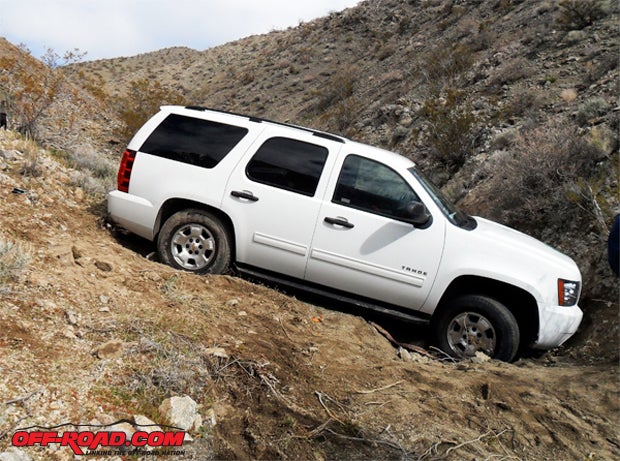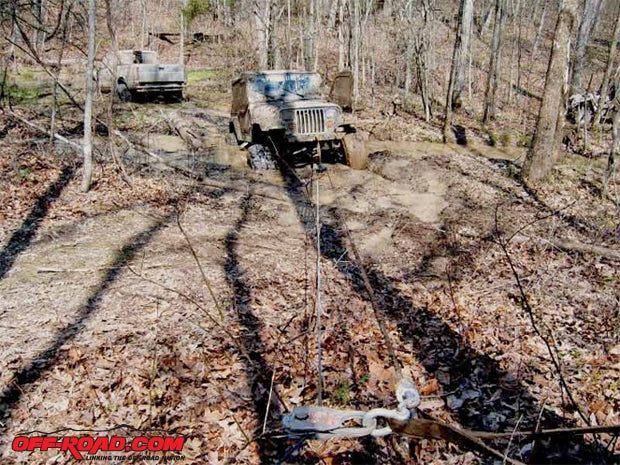
Following up on last month’s article, A Primer on Winching, Part 1, we’ll delve deeper into the winching process. As with the previous column, this information comes from my exclusive Winch Recovery Bandana, which you can purchase from the Badlands Off-Road Adventures website.
Winch Kit
All successful winching starts with a good winch kit. That kit should include a pair of sturdy, loose fitting leather gloves, a tree strap 15 to 16 feet long, a heavy blanket, four to six D-rings, and a piece of 70 grade 3/8” chain (10 feet is long enough). Let’s look at each component.
Sturdy leather gloves are mandatory. Steel winch line develops small broken wires that will tear into your hands. Loose fitting gloves allow you to pull your hand out if the gloves become caught in the winch or line. A tree strap that is at least 15 feet long will be long enough to go around larger trees. This is done to protect the tree. A chain or cable will cut into the bark, mortally wounding the tree. Also, cable that’s wrapped around a tree and hooked back on itself develops a kink, which weakens the cable. The blanket is used as a “parachute” and placed over the winch line during winching to dampen recoil should the winch line break.
The chain, by the way, needs to be sturdy. Chain strength is given in grades; the higher the number, the stronger the chain. The Working Load limit (WLL) of the chain needs to be in the same range as the rest of your gear. Using high-grade chain (like grade 70) allows appropriate strength in a smaller link size that is easier to store and manage. Chain found at hardware stores is typically around a 43 grade. You will need quite a large link size at that grade. Go with 70 grade or higher (if you can afford it). Higher-grade chains have each link welded for extra strength. Finally, having four to six D-rings puts more options at your disposal, especially for complicated winching.
Previous Trail Tip Stories
A Primer on Off-Road Winching
How to Replace U-Joints on Your 4x4
What Causes Washboard Roads?
What is Working Load Limit?
I want to stress one thing: Never use equipment whose rating – either working load limit (WLL) or breaking limit – you don’t know. If that information is not on the item, do not use the part. You could put yourself and everyone else in danger.
Working load limit, previously called safe working limit, is just what it means: the maximum stress that the item is designed to handle while in use. For safety reasons, the WLL of winching components is about one-fifth of the item’s breaking strength. Let’s look at some examples. The WLL for grade 70 3/8” chain is 6,600 lbs. D-rings should have a minimum of 3/4” pin. That size has a WLL of 9,500 lbs. You can find the WLL for other sizes of parts on my winching bandana.
After purchasing the parts, if the WLL is only indicated on the package it comes in, make sure you transfer the WLL onto the part permanently. A permanent marker (magic marker or Sharpie) works great on tree straps, whose packaging you pitch after opening. For pulleys and D-rings, carve the information with an engraving pen into the metal. Original sticky labels and markings tend to wear off over time.
Also, never use a recovery strap for winching. Recovery straps are designed to stretch. That stretching builds energy, which is used to snatch a stuck vehicle free. A jerking action while winching is dangerous because of all the metal parts used. A recovery strap adds additional recoil to the winch rigging which is not desirable. If that strap were to break, you’d have a bunch of steel missiles flying around. For winching, we want a nice, steady pull.

Winching Starts with a Vehicle Recovery Plan
A winching operation is serious business and should be treated as such. Take your time to think it through before proceeding. The following steps are outlined under the Vehicle Recovery Plan section of the bandana.
Make sure everyone in the affected vehicle is safe, especially if the vehicle rolled over. Be prepared to provide first aid, but also make sure the vehicle itself is stable. If not, you may need to attach straps or cables first. Also, look for any hazards that could endanger the recovery crew.
Be careful if the vehicle is perched on its side. You don’t want it dropping on top of you while you’re attaching the cable.
A vehicle recovery plan is essential. Gather everyone together. Get their input, and determine the best course of action. Don’t let anyone start rigging up until you’ve decided what to do. If need be, appoint a leader. Have someone (that could be you) take charge of the situation. The winching should be done in an orderly manner.
Inspect the vehicle. Are there any broken of dangling parts that could affect the recovery? What about leaking liquids? Do something to capture those until you can devote time to the environmental issues and clean up.
Determine your exit path, and get a lay of the land. See if there are any obstacles you’ll need to overcome. What is the best direction to go? It’s always easier to go downhill, but you may find that pulling a few feet up and over a hill or obstacle makes more sense.
If the vehicle is on a slope, set the emergency brake. You don’t want the vehicle rolling downhill once it’s freed up.
Plan the rigging. Estimate your stuck load, and calculate whether you have the capability to handle the load. (See the sidebar for more information.) Pulleys add friction, so remember to add 10% to the load for each pulley used.
But pulleys also aid in pulling. A full discussion is beyond the scope of this article. Just remember that when you use one "moving" pulley, the winch “sees” only one-half of the total load. (Only one-third, if two "moving" pulleys are used.) The total load may be 10,000 lbs. but the winch needs to pull only 5,500 lbs. (10,000 plus 10% for the pulley divided by 2).
Last Step
Set up the rigging and double check it. Take up the slack and re-inspect for correct assembly. Proceed with the recovery.
This may seem like a lot of steps—especially when you’re following off the bandana—but after doing a couple, it’s easy to pick up the fundamentals of winching. For additional, hands-on training, sign up for one of my winching courses.
Badlands Off-Road Adventure
Off-road trainer Tom Severin shares insight and tips on a variety of topics related to preparing you for that next off-road adventure. With over 40 years of off-road experience, Severin operates under his business Badlands Off-Road Adventures. He is a certified professional 4WD Trainer by the International 4-Wheel Drive Trainers Association and a Wilderness First Responder (WFR). He is a member of the California Association of Four Wheel Drive Clubs (CA4WDC), United Four Wheel Drive Associations and the BlueRibbon Coalition. He also is a certified UFWDA and a CA4WDC 4WD instructor.
For more information about Badlands Off-Road Adventures, visit http://www.4x4training.com/.


 Your Privacy Choices
Your Privacy Choices